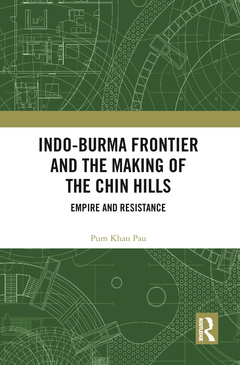Indo-Burma Frontier and the Making of the Chin Hills Empire and Resistance
Auteur : Pau Pum Khan

This book examines the British colonial expansion in the so-called unadministered hill tracts of the Indo-Burma frontier and the change of colonial policy from non-intervention to intervention. The book begins with the end of the First Anglo-Burmese War (1824?26), which resulted in the British annexation of the North-Eastern Frontier of Bengal and the extension of its sway over the Arakan and Manipur frontiers, and closes with the separation of Burma from India in 1937. The volume documents the resistance of the indigenous hill peoples to colonial penetration; administrative policies such as disarmament; subjugation of the local chiefs under a colonial legal framework and its impact; standardisation of ?Chin? as an ethnic category for the fragmented tribes and sub-tribes; and the creation and consolidation of the Chin Hills District as a political entity to provide an extensive account of British relations with the indigenous Chin/Zo community from 1824 to 1935. By situating these within the larger context of British imperial policy, the book makes a critical analysis of the British approach towards the Indo-Burma frontier.
With its coverage of key archival sources and literature, this book will interest scholars and researchers in modern Indian history, military history, colonial history, British history, South Asian history and Southeast Asian history.
Foreword. List of Illustrations and Tables. List of Abbreviations. Preface. Foreword. Introduction 1. Situating the Indo-Burma Frontier within the Larger Context of British Imperial Policy 2. Frontier Policy: Problem of the Arakan Frontier 3. Manipur Frontier: Kamhau-Sukte and Meitei Relations 4. Colonial Penetration: Explorations, Expeditions and Resistance 5. Colonial Policy Backfired: Disarmament and Resistance 6. Administrative Developments: ‘Indirect Rule’ and the Making of Colonial ‘Agents’ 7. The Chin Hills District: Towards Consolidation. Conclusion. Glossary. Appendices. Bibliography. Index
Pum Khan Pau is Assistant Professor, Department of History, Visva-Bharati University, Santiniketan, West Bengal, India. He was Raman Post-Doctoral Fellow at Arizona State University, USA (2014–15). His area of specialisation is in the history of the indigenous tribes of the Indo-Burma borderlands during colonial and postcolonial times. He has published in the Indian Historical Review, Strategic Analysis, Journal of Imperial and Commonwealth History, Journal of Religion and Society, Journal of Burma Studies, Journal of Borderlands Studies, Small Wars and Insurgencies, and chapters in edited volumes.
Date de parution : 03-2021
15.6x23.4 cm
Date de parution : 08-2019
15.6x23.4 cm
Thème d’Indo-Burma Frontier and the Making of the Chin Hills :
Mots-clés :
Chin Hills; Young Man; British Camp; Lushai Hills; Chittagong Hill Tracts; Zo People; Chin Lushai Expedition; Hill Tracts; Deputy Commissioner; Fort White; West Bengal State Archives; Northern Arakan; South Lushai Hills; North Eastern Frontier; Anglo-Burmese War; Lushai Expedition; National Library; Assistant Political Officer; Arakan Hill; India’s Economic Relations; Colonial Administration; Naga Hills; Sea Board; India Act; Chief Commissioner



